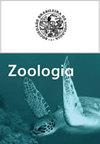Structure of the leaf litter frog community in an area of Atlantic Forest in southeastern Brazil
IF 1.8
4区 生物学
Q4 ZOOLOGY
引用次数: 1
Abstract
Different spatial and temporal factors can influence the species richness and abundance of leaf anurans that are fundamental for the ecosystem functioning, as they act as predators and integrate the trophic chain as prey of other animals. There are relatively few studies that aimed to understand the spatio-temporal variation and the influence of environmental factors on leaf litter communities. We studied parameters of the anuran community living in the forest leaf litter in the Duas Bocas Biological Reserve (DBBR), Espírito Santo, Brazil. We sought to understand the extent to which richness, abundance, biomass and density varied between two locations with different stages of preservation (primary and secondary forest). In addition, we tested the effect of temperature and local humidity on abundance. We conducted the samplings monthly from October 2017 to September 2018, establishing 98 4 x 4 m plots (16 m2 each) demarcated on the DBBR forest leaf litter. We measured temperature (°C) and relative air humidity (%), and each plot was carefully surveyed by four observers. We tested for differences in anuran density between the two sampled locations and estimated the effects of environmental variables in the community. We recorded 102 individuals of anurans from 11 species belonging to eight families. The DBBR anuran community parameters significantly differed between the two studied locations, with the highest values of anuran richness and abundance occurring in the area covered by primary forest, probably due to differences in the preservation of each area. However, temperature and humidity did not affect the abundance of anurans in the sampled areas. Our results provide the first information about spatial variation and influence of environmental factors, directed to the community of leaf litter anurans in DBBR, and represents the second study on this group of anurans in the state of Espírito Santo.巴西东南部大西洋森林凋落叶蛙群落结构
不同的时空因素会影响叶蛛的物种丰富度和丰度,而叶蛛是生态系统功能的基础,因为它们作为捕食者并作为其他动物的猎物整合营养链。但对凋落叶群落的时空变化及环境因子影响的研究相对较少。研究了巴西圣托Espírito Duas Bocas生物保护区(DBBR)森林凋落物中生活的无尾猴群落参数。我们试图了解丰富度、丰度、生物量和密度在不同保存阶段(原生林和次生林)的两个地点之间的变化程度。此外,我们还测试了温度和当地湿度对丰度的影响。从2017年10月至2018年9月,我们每月进行一次采样,在DBBR森林凋落物上划分了98个4 × 4 m(每个16 m2)的样地。我们测量了温度(°C)和相对空气湿度(%),并由四名观察员仔细调查了每个地块。我们测试了两个采样地点之间anuran密度的差异,并估计了社区环境变量的影响。记录了8科11种无尾动物102只。两个研究地点的DBBR野蛙群落参数差异显著,野蛙丰富度和丰度在原生林覆盖的地区最高,可能是由于每个地区的保护程度不同。然而,温度和湿度对采样地区的无尾蝇丰度没有影响。我们的研究结果首次揭示了DBBR凋落叶蚁群落的空间变化和环境因子的影响,是对Espírito Santo州凋落叶蚁群体的第二次研究。
本文章由计算机程序翻译,如有差异,请以英文原文为准。
求助全文
约1分钟内获得全文
求助全文
来源期刊

Zoologia
生物-动物学
自引率
0.00%
发文量
15
期刊介绍:
Zoologia, the scientific journal of the Sociedade Brasileira de Zoologia (SBZ), is an international peer-reviewed, open-access Zoological journal that publishes original research on systematics, evolution, taxonomy, nomenclature, biogeography, morphology, physiology, biology, ecology, symbiosis, conservation, behavior, genetics and allied fields. The journal, formerly known as Revista Brasileira de Zoologia, publishes original articles authored by both members and non-members of the Society. The manuscripts should be written exclusively in English.
 求助内容:
求助内容: 应助结果提醒方式:
应助结果提醒方式:


